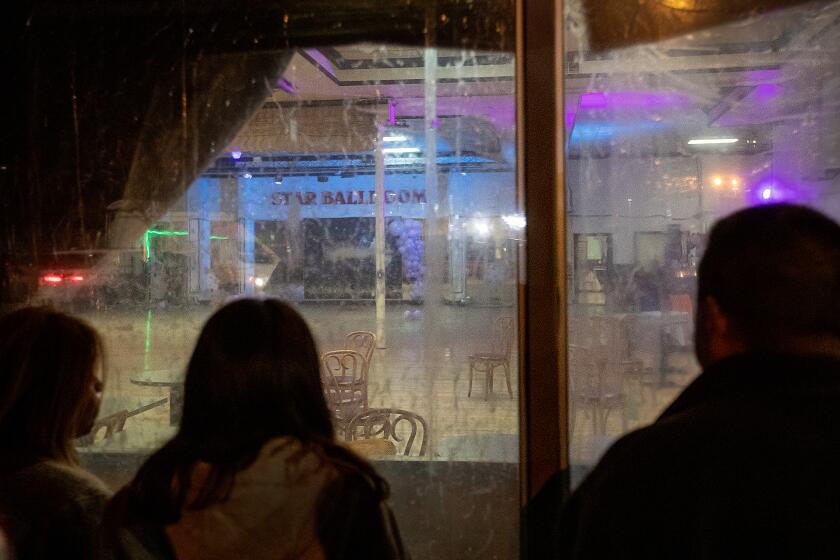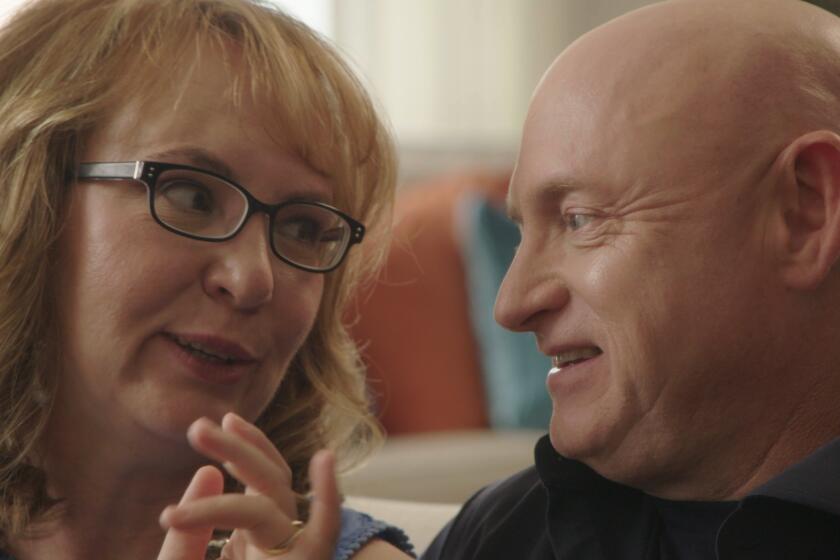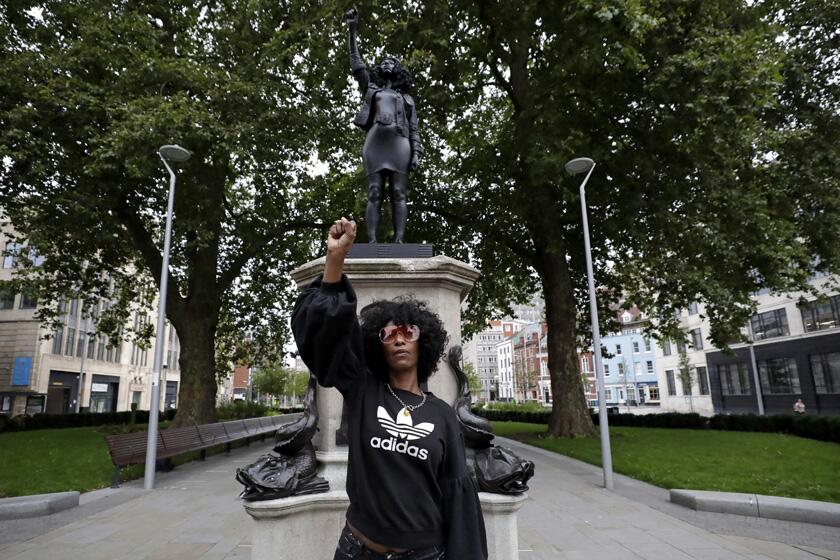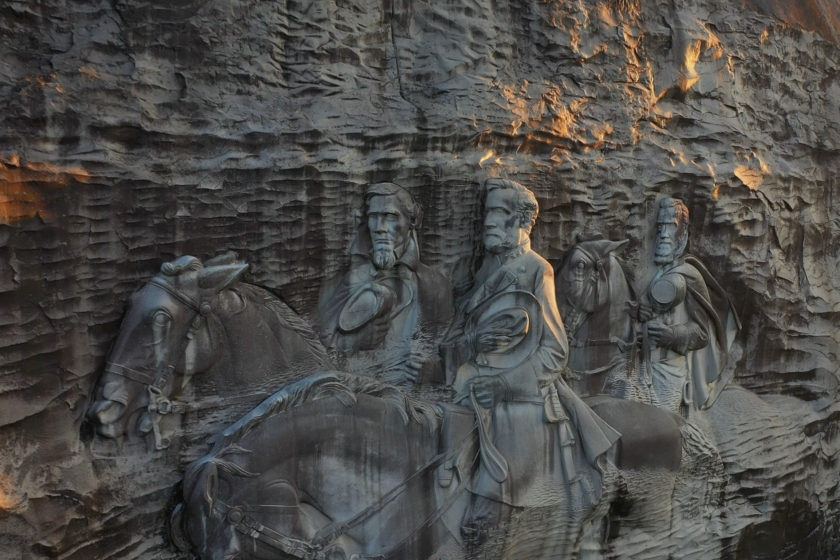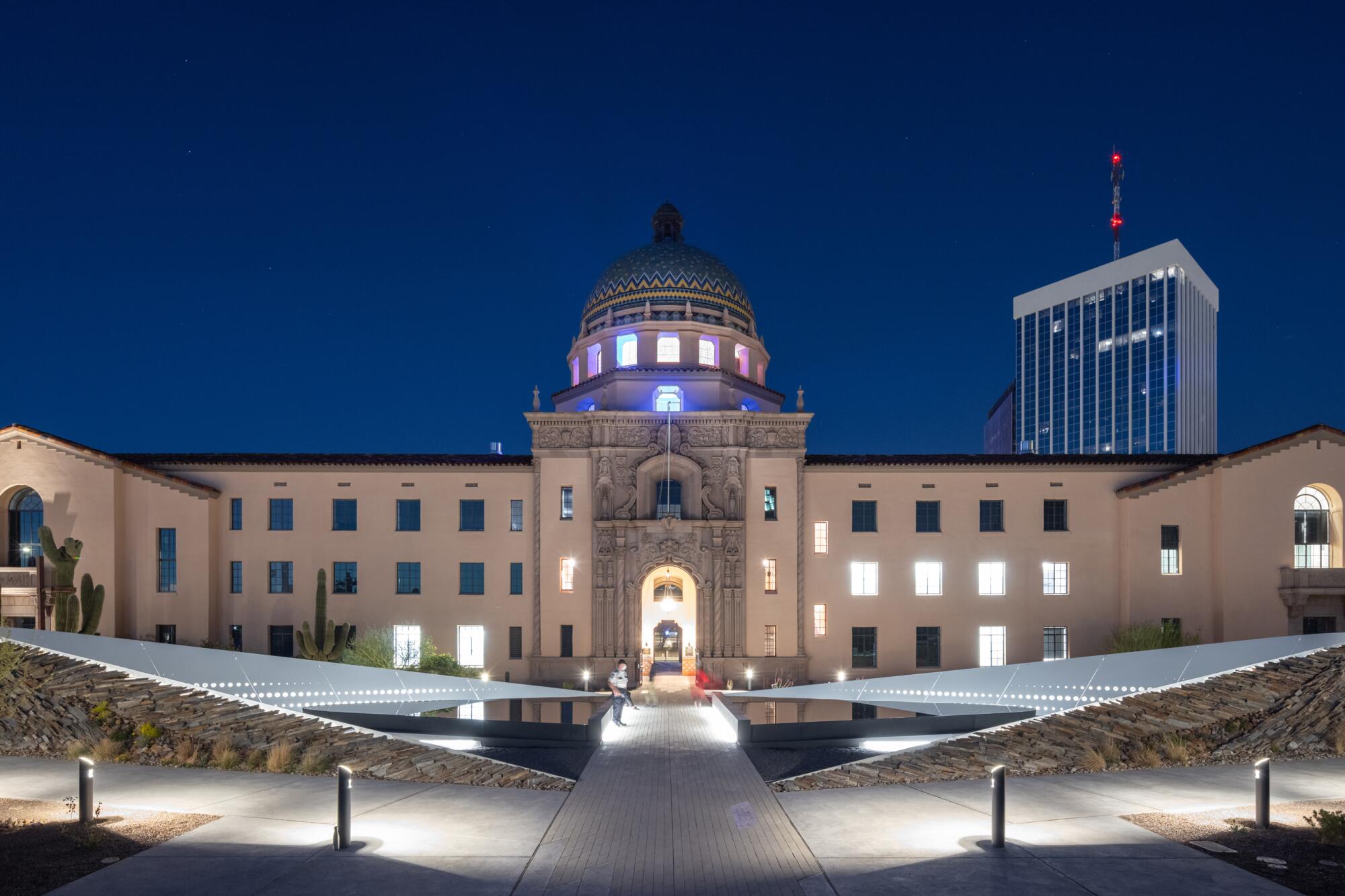
Tucson — If you were to hover over El Presidio Plaza in downtown Tucson, you might catch sight of an earthen form resembling a point of impact, as if some object from the heavens had come careening to Earth and displaced several tons of vegetation and rock. Within this crater are a pair of symmetrical black limestone pools whose forms evoke elegant gems.
To observe this place is to see a landscape that has been indelibly marked by an extraordinary event. That event was the mass shooting of January 8, 2011, when a gunman killed six people and injured 13 at a “Congress on Your Corner” gathering organized by then-U.S. Rep. Gabrielle Giffords at a Safeway supermarket. Among the dead was 9-year-old Christina-Taylor Green, who had just been elected to her school’s student council. Giffords, who was shot in the head, survived, but has lived with paralysis and aphasia ever since.
Ron Barber, an aide to Giffords, who later succeeded her as U.S. representative, was shot twice. He watched people die that day, but he also saw his community rise to the occasion. Standing before one of the black limestone pools, as survivors and victims’ families gathered to mark the 12th anniversary of the attack, he told me, “They embraced us in every way you could imagine.”
The January 8th Memorial now serves as a permanent expression of that moment — both the tragedy and the communal recovery.
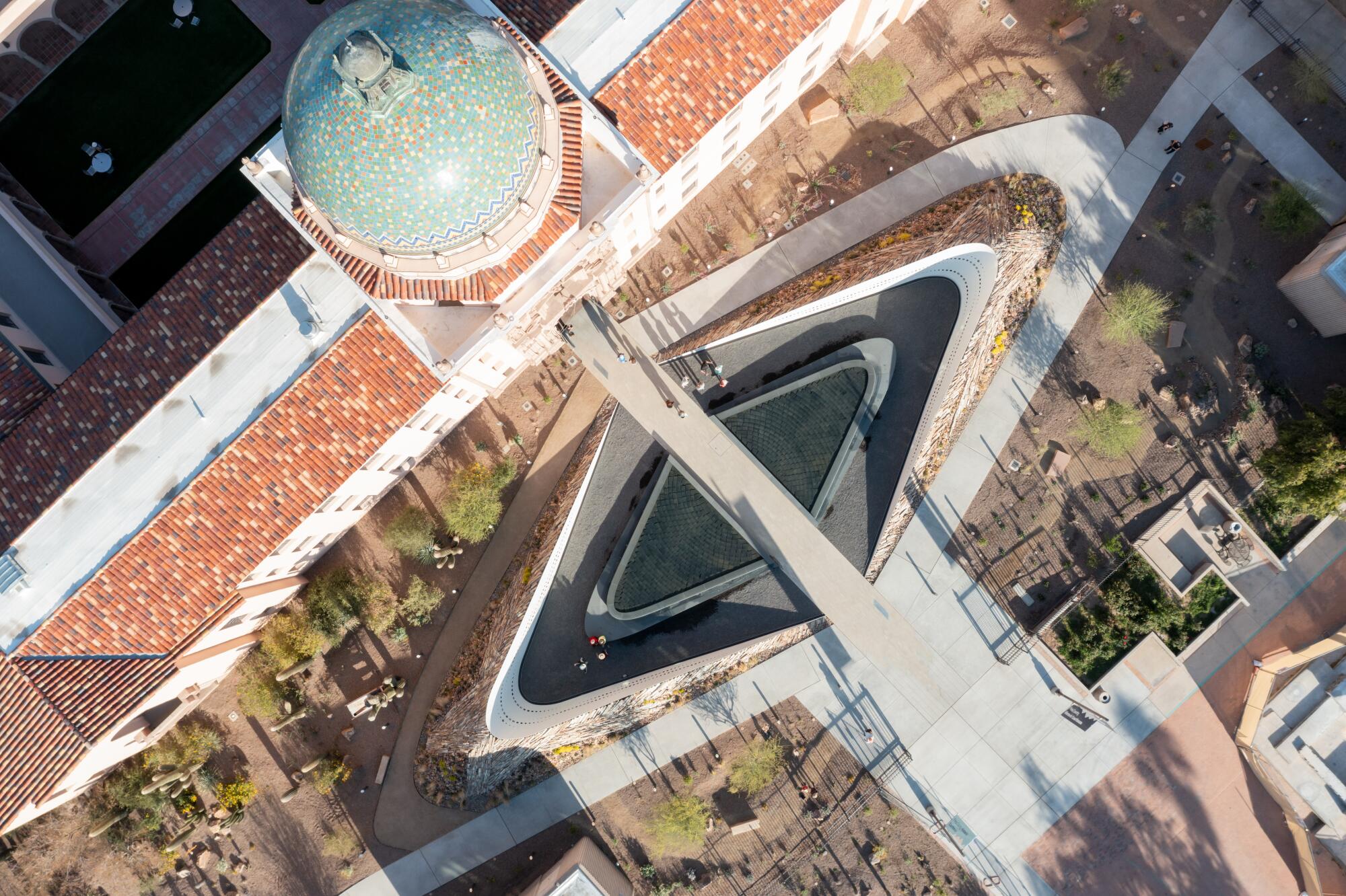
Welcome to a uniquely American form of monument-making: the memorial to the mass shooting.
The January 8th Memorial was designed by a team that included landscape and architecture firm Chee Salette and artist Rebeca Méndez — who are based in Los Angeles — with lighting design by Wilfried Kramb of the German firm agLicht.
It joins a wave of mass-shooting monuments around the country. In 2021, the city of Annapolis, Md., dedicated a memorial designed by Moody Graham to the 2018 murder of five people in the Capital Gazette newsroom. Last year, the Curtain of Courage, designed by landscape architect Walter Hood, was unveiled at a county building in San Bernardino to mark the 2015 mass shooting that left 14 dead and 21 injured. Not five months later, Newtown, Conn., unveiled its own monument to the Sandy Hook elementary school shooting of 2012, an attack that took the lives of six educators and 20 very young students. That project was designed by landscape architecture firm SWA.
Slightly older monuments mark place-names that dominated headlines after an attack — Columbine, Aurora, El Paso — before fading into a haze of thoughts and prayers and news of the shooting that inevitably followed.
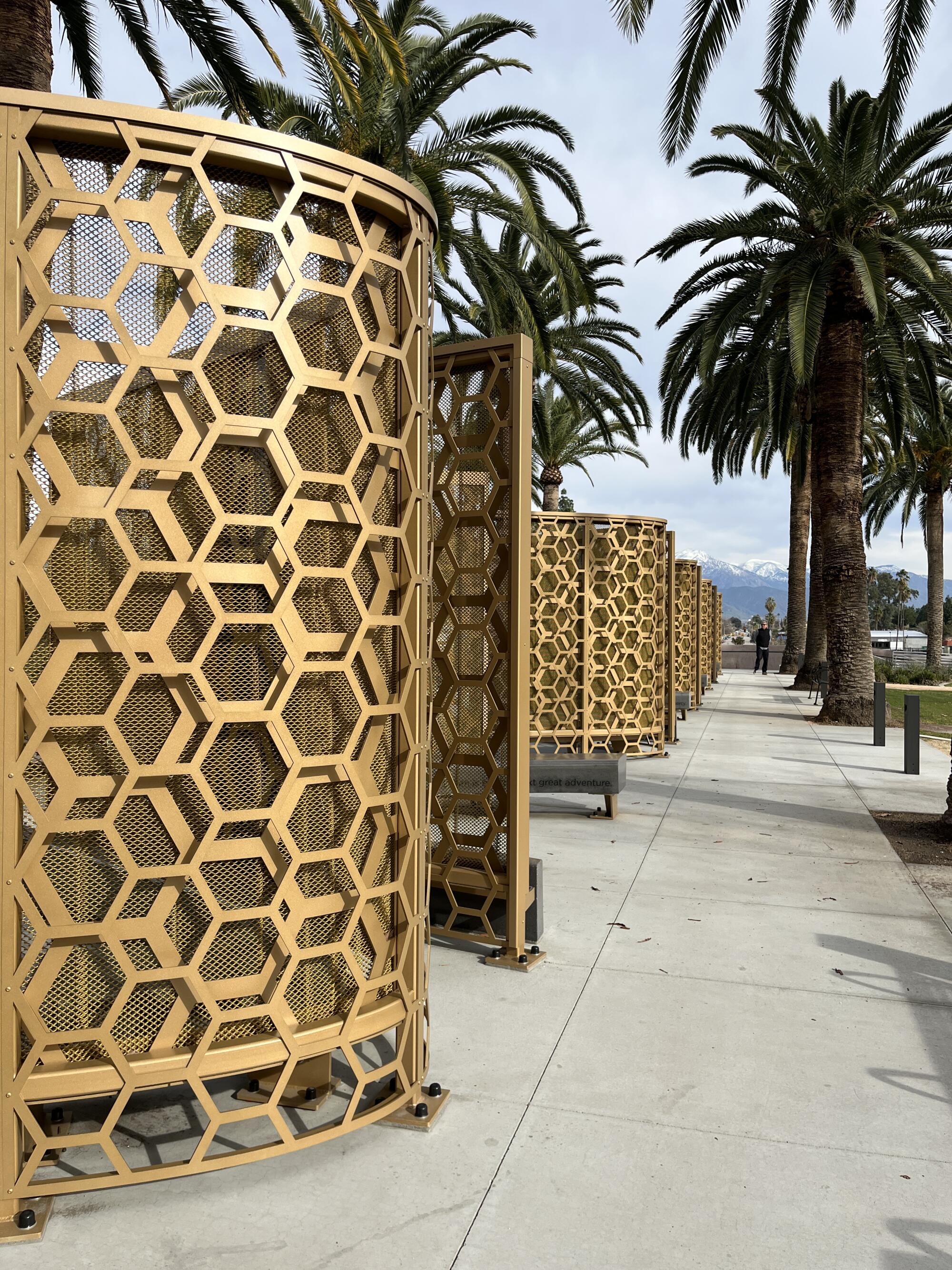
Southern California is home to one of the earliest mass shooting memorials, dedicated in 1990: a series of stacked marble towers, created by Roberto Valdes, that stand before Southwestern College in San Ysidro, on the site of the 1984 mass shooting at a McDonald’s that left 19 injured and 21 dead.
The region may also end up being home to one of the newest such memorials. Last Saturday a mass shooting at a dance studio in Monterey Park left 11 people dead and 9 injured. One of the worst shootings in the history of Los Angeles County, it turned a lively Asian immigrant enclave celebrating the Lunar New Year into a war zone, with police tape blocking streets that still bore hopeful signs exclaiming, “Happy Year of the Rabbit!” That attack was followed Monday by another mass shooting in Half Moon Bay that killed 7 people.
Tucson’s crater-like monument notwithstanding, these impacts feel less like the strikes of meteors than the devastations of a cancer devouring us from within.
Gun violence is an inexorably political topic in the U.S. But according to Paul Farber, director of Monument Lab, a non-profit organization in Philadelphia that studies monuments, these spaces to some degree represent an unusual level of collaboration: “They create a space for public feeling that policy does not.”
As a general rule, public memorials mark episodes of violence, Farber notes — be it war, massacres or conquests — and monuments to mass shootings are no different. “We’re at war with ourselves,” he says, “and we don’t have a language for it.”
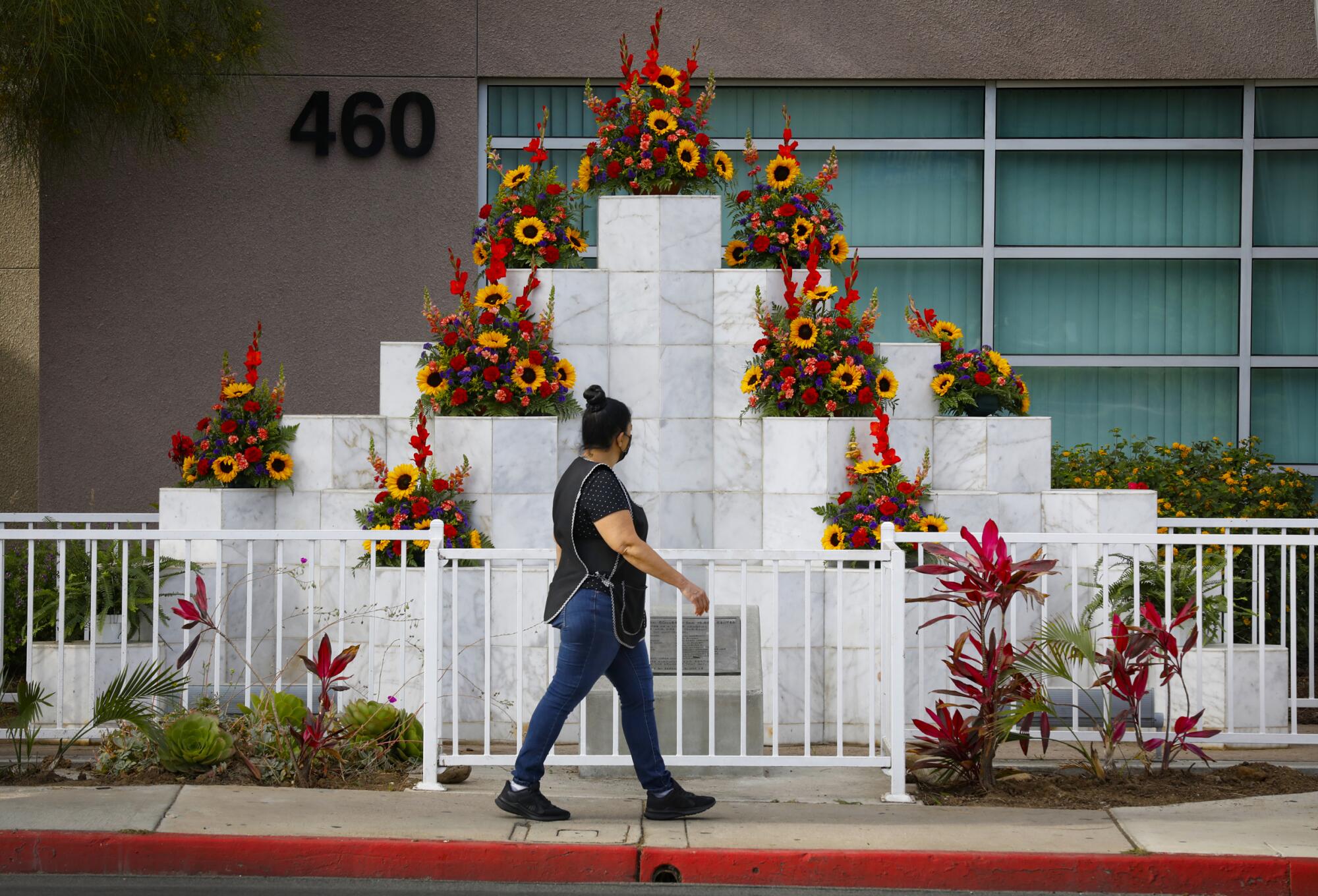
A gunman opened fire at a Monterey Park dance studio late Saturday, killing 10 people and wounding 10. He went to another dance studio in Alhambra but was disarmed by two people and later killed himself in Torrance.
The Tucson memorial is an impressive one — for its scale, its design and the very prominent site it inhabits.
Walk around downtown and you are liable to traverse the monument’s expanse. Its earthen berms frame the Pima County Historic Courthouse, a beloved 1929 Spanish Colonial Revival building designed by Tucson architect Roy Place that now harbors a visitor center and a museum. Across the plaza, to the west, lies City Hall; to the north, the Tucson Museum of Art.
The memorial is no obscure little plaque at the site of the Safeway — it sits in the civic center of Arizona’s second largest city. The significance of the site reflects the gravity of the crime: The attack on Giffords was a direct assault on the democratic process.
“The fact that they chose this spot at the historical heart of the city gave it a different type of importance,” says architect Marc Salette, of Chee Salette. “It allowed us to develop a layer of messaging that was about the context as opposed to just talking about a small moment in time.”
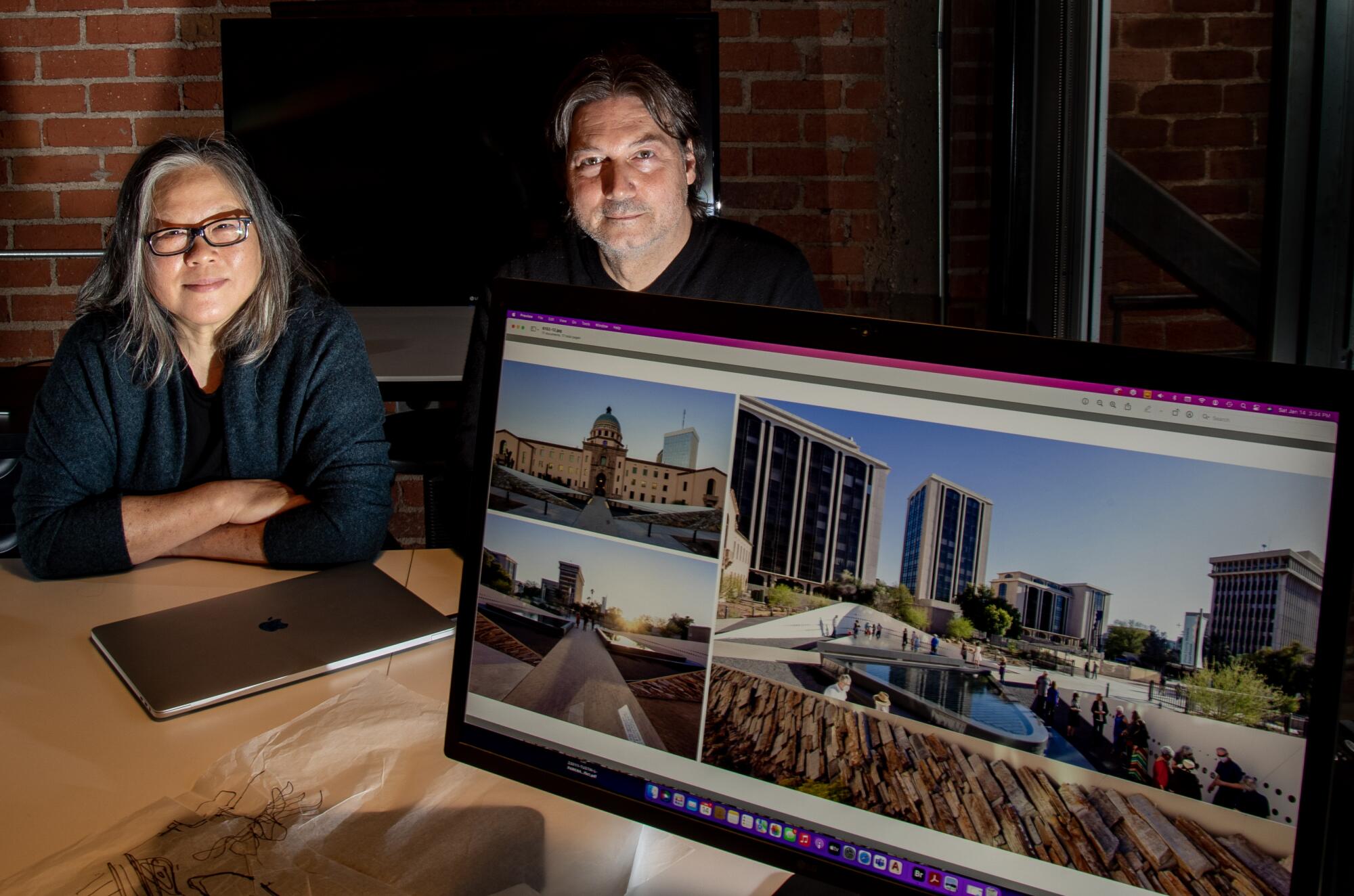
The documentary ‘Gabby Giffords Won’t Back Down,’ directed by Betsy West and Julie Cohen, details the former congresswoman’s life since 2011 shooting.
That layering allows myriad stories to unfold.
First is the story of the shooting — and the way people came to one another’s aid. Barber recalls Safeway employees rushing out of the store to aid the wounded: “They brought stuff to stop wounds, they brought aprons from the deli to cover the dead. They were so brave.” Even after the headlines subsided, he says, friends delivered meals and strangers approached him with words of encouragement.
The memorial is known as “the Embrace” — a concept rendered as a pair of symmetrical V-shaped berms containing two low-lying fountains circumnavigated by a gravel path. To walk into the monument is to feel the earth rise around you. Its exteriors are covered in quartzite rock arranged to evoke Indigenous basket weave patterns; from crevices emerge bursts of desert plants.
“We wanted something that would rise up out of the land and that would be full of life on the exterior — that community,” says landscape architect Tina Chee, of Chee Salette. “But the inside is more solemn. It needed to have that contemplative space.”
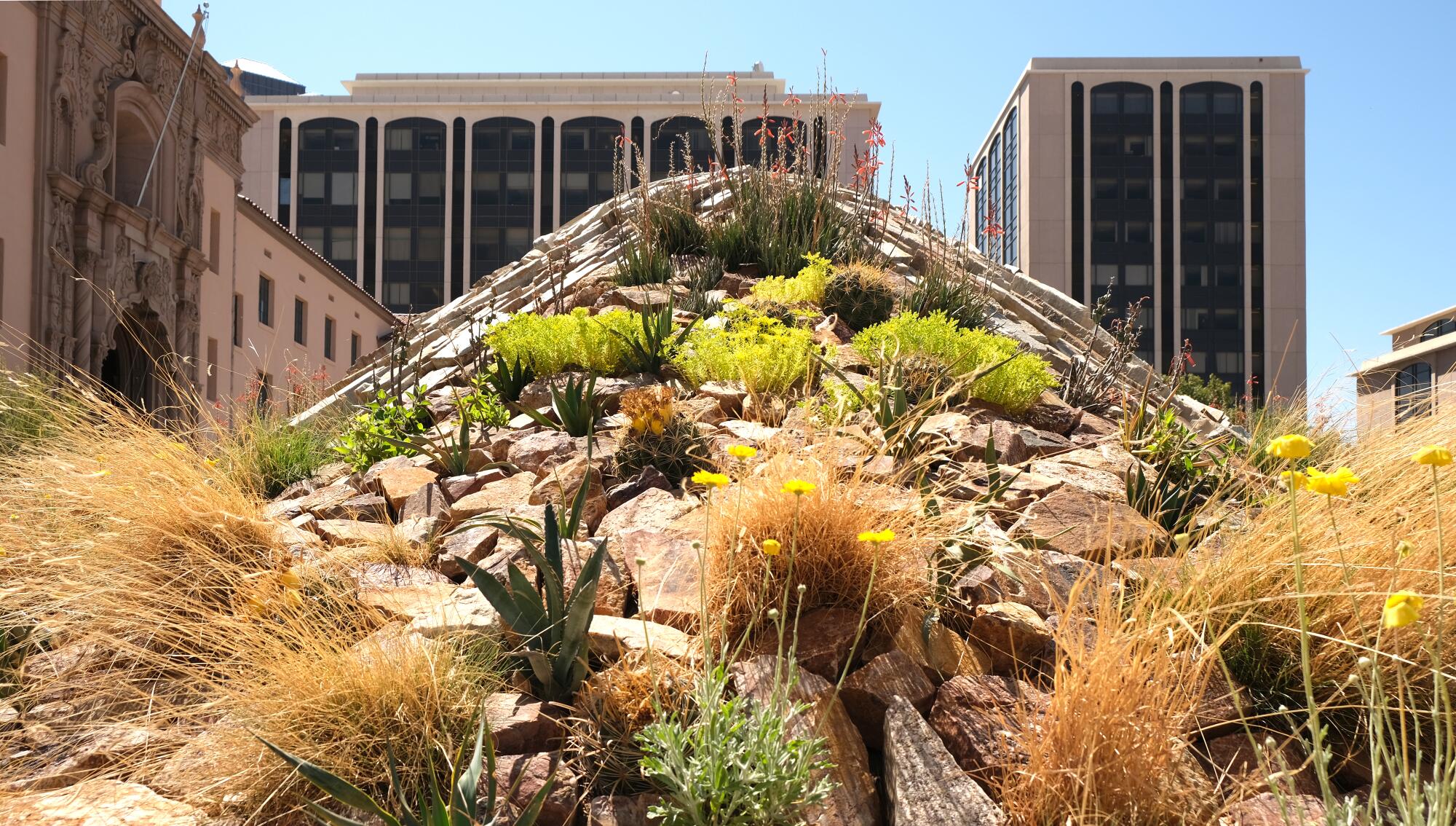
If the outside of the berms is riotous nature, the interior is sleek and calm; gently sloping white walls bear glyphs inspired by Hohokam petroglyphs found in Southern Arizona. Each of these stylized symbols represent passions or ideas connected to the people killed or wounded in the attack. Say, a butterfly, a baseball, a mama bear — the last one in honor of survivor Mary Reed, a mother who threw herself over her daughter and took the bullets in her stead.
Each symbol resides within a circular cut-out that echoes the shape of a bullet hole. During the day, the sunlight penetrates the glyphs, casting shadows on the berm wall behind them; at night, they are illuminated from within. Many monuments read like a roll call of names, but the glyphs imbue the January 8th memorial with the richness of lives well lived.
“The combinations of these symbols can say so much more than a paragraph,” says Méndez, who worked with survivors and victims’ families to develop individualized symbols. “People from all walks of life were involved in this event. I just wanted to go beyond language and really move us to a place where we all understand each other.”
There are names listed in the memorial, but they are discreetly carved into the bases of the fountains.
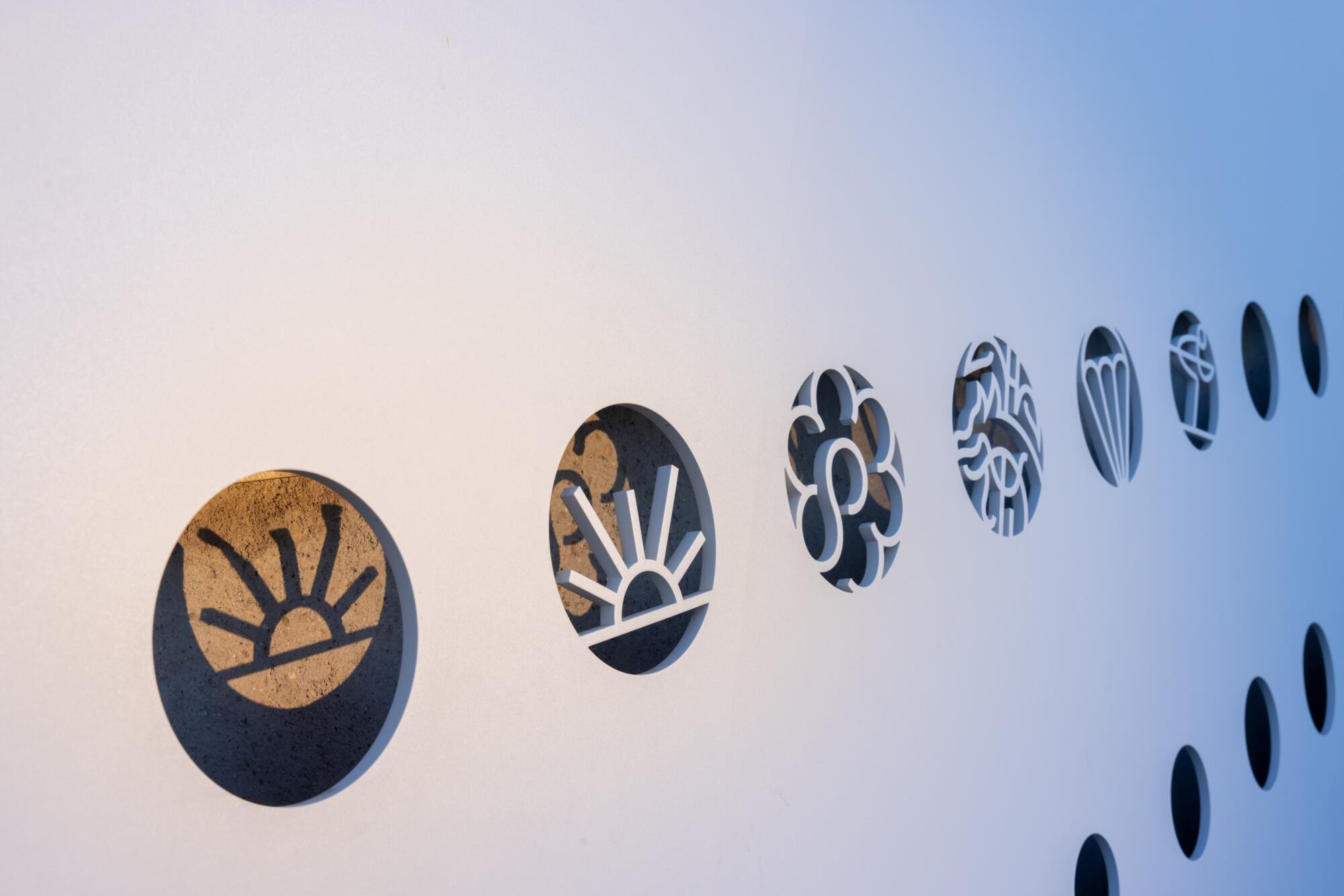
The stories embedded in the memorial go beyond simply reckoning with the calamities of January 8th.
El Presidio Plaza, whose recorded use dates back to the 16th century, marks the city’s historic core, a center for successive waves of settlement — Indigenous, Spanish, Mexican and Anglo. The monument acknowledges this history via a ring of lights around the perimeter, each sporting a glyph representing a historical event. Some reference natural history, such as nearby Sentinel Peak, once the site of a major Tohono O’odham village. (The name Tucson is derived from an Indigenous phrase meaning “Black Hill” or “Black Mountain.”) Other glyphs mark the founding of the San Xavier del Bac Mission in the 17th century and the establishment of Arizona as a U.S. state at the beginning of the 20th.
Historian Jackie Kain worked with the design team to engage local scholars and tribal historians for their input. “This is calling forward the people who have lived there, died there and still live there,” she says. “It’s incredibly evocative.”
It also acknowledges histories too often overlooked by monuments. Within El Presidio Plaza, there are monuments to colonization, the Battle of the Bulge and John F. Kennedy. But until the January 8th Memorial was completed, there wasn’t a single marker that specifically engaged the area’s Indigenous history.
“It’s like there is a gesture to place this into a continuum,” says Farber. “It isn’t a day that can be separated from time, but it’s ingrained into the landscape.”
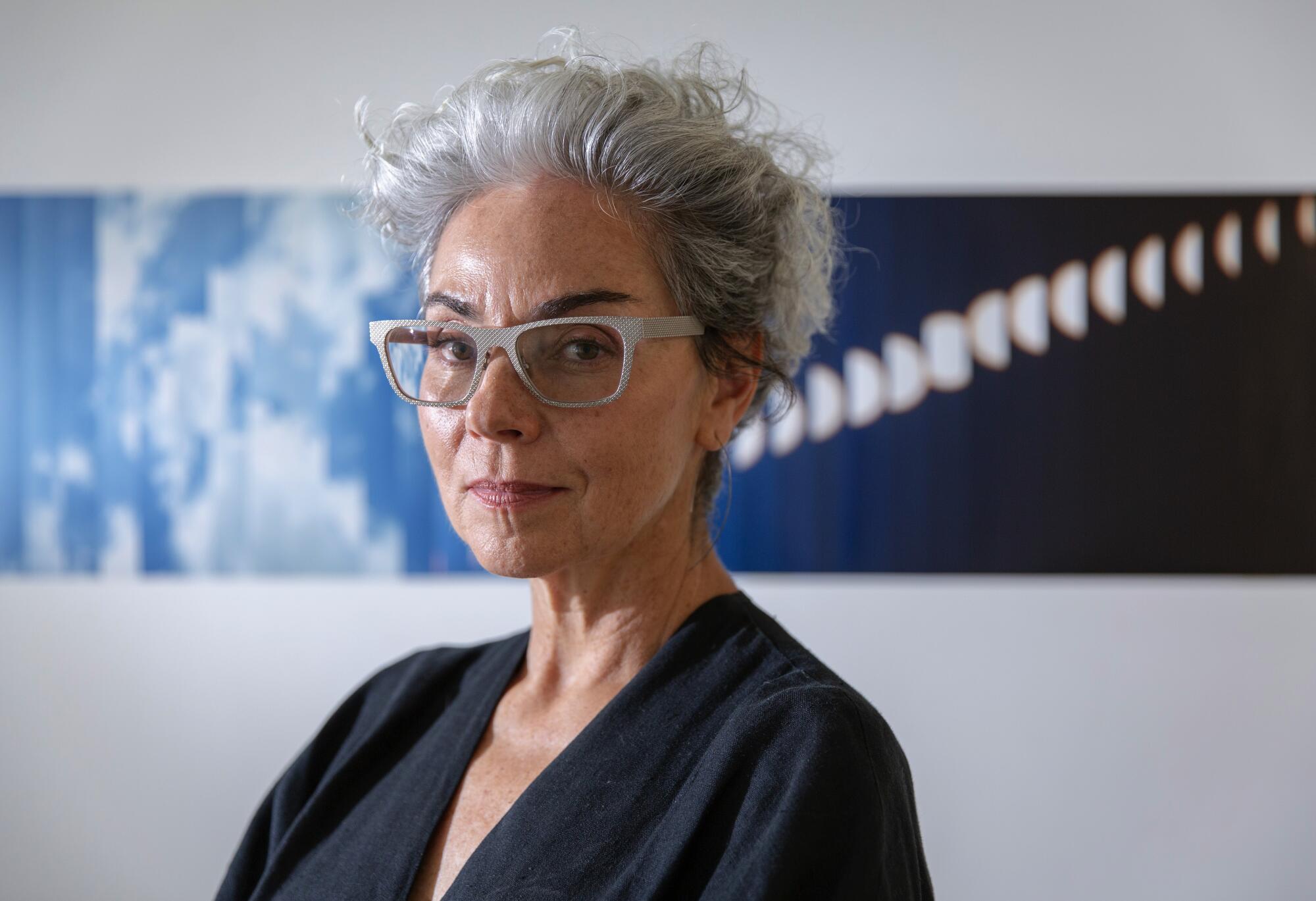
The January 8th Memorial balances an array of concerns — creating moments of serenity at a well-trafficked site, honoring the shooting and also engaging a broader history.
The berms of the Embrace are ringed by a series of graceful desert gardens that honor the six people who died. (Phyllis Schenk, for example, loved cooking, so the garden bearing her name features aromatics.) During an evening visit, I found a couple perched on a boulder in one of the gardens, engaged in quiet conversation — a site of remembrance doubling as one of placid escape.
Shouldn’t public monuments have public input? In the George Floyd moment, artists and designers are changing the nature of monuments and the histories they honor.
Most impressive is how this monument has navigated the fraught politics of gun control. For the memorial’s builders, it has been a delicate dance. Neither guns nor the shooting is mentioned in the limited text elements onsite. And throughout its development, organizers were careful to describe the monument as one that honored the community at large.
“The point was to create a memorial and not take a position on gun safety or gun violence,” says Karen Christensen, who served as board president of the January 8th Memorial Foundation, the non-profit group that brought the monument to fruition. “The foundation was non-partisan.”
But the gun debate has nonetheless lurked unspoken. Months after the shooting, the Arizona Legislature passed a bill to designate the Colt single-action Army revolver as the state’s official gun. When it came time to fund the memorial, however, the proposed bill quietly died in committee. (Construction ultimately came to $3.6 million, funded via a combination of private philanthropy and county funds.)
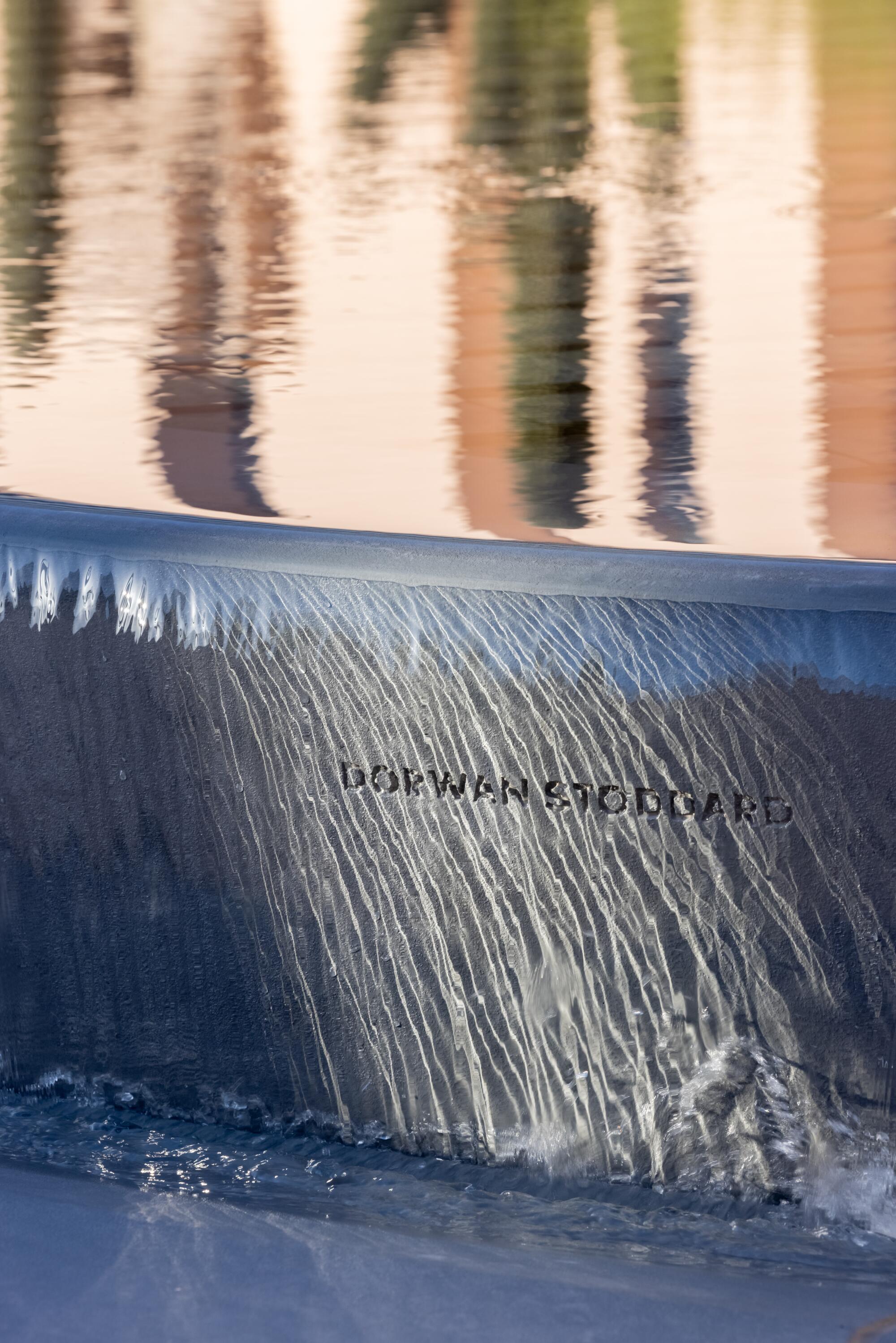
The Atlanta History Center’s “Monument: The Untold Story of Stone Mountain” peels back the troubled history of the largest monument to the Confederacy.
The memorial was completed in 2021, but its opening was muted by the pandemic. Earlier this month, a group of survivors and their families — about two dozen people — gathered within one of the berms to mark the anniversary.
The shooting took place on a brilliant, sunny morning — much like the morning of the anniversary. At 10:10 a.m., the time of the shooting, the assembled group observed a moment of silence. The air was still and the white walls of the monument gleamed. Afterward, the names of the dead were recited, each accompanied by the ding of a bell.
After this informal rite, the group lingered. Hugs were exchanged. Pictures were taken. Stories were recounted. The solemn mood was replaced by one of quiet camaraderie. The group of survivors and their loved ones, says Christensen, have “become like a family.”
“It’s a very strange club,” she adds, “one you wouldn’t want to be a part of.”
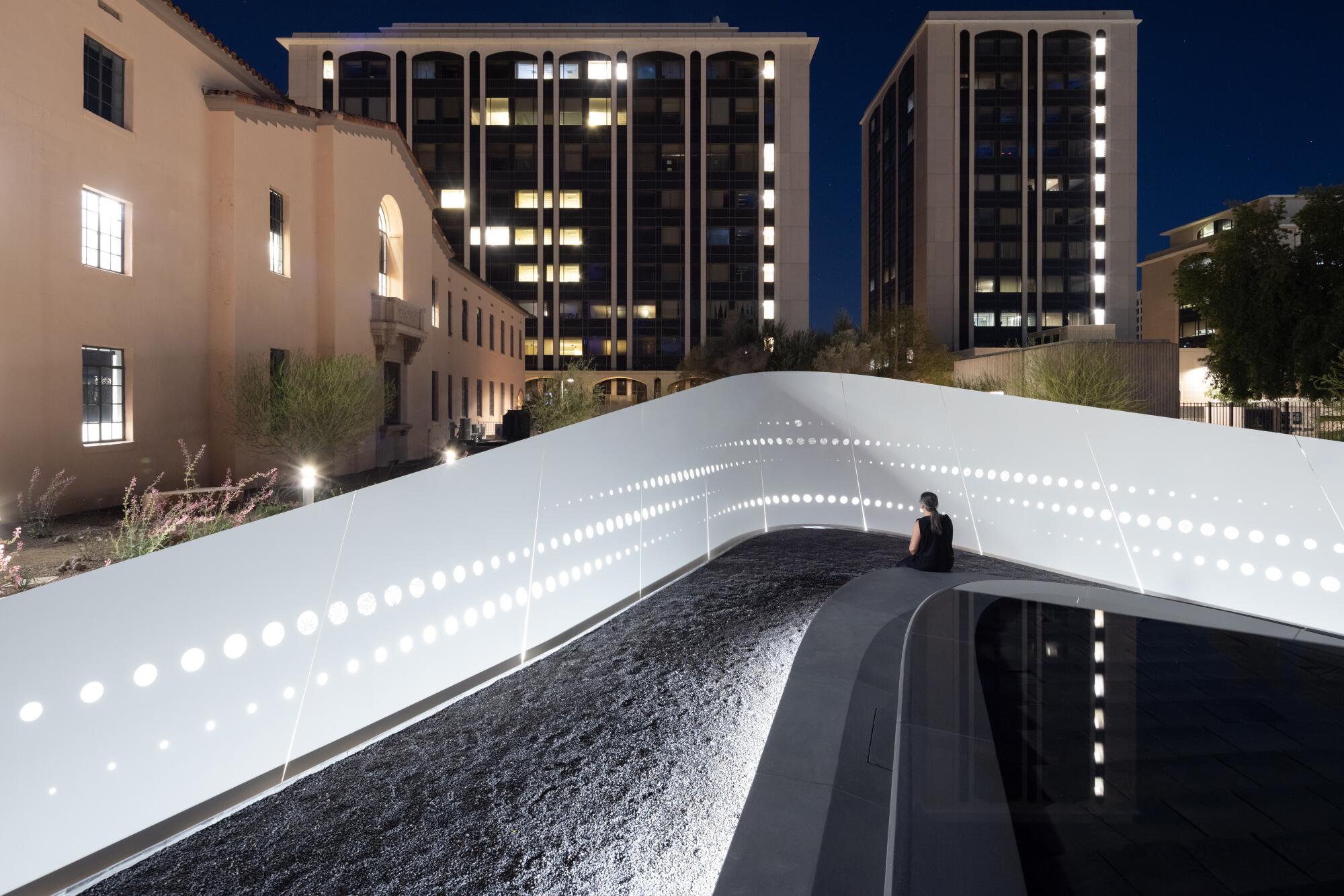
More to Read
The biggest entertainment stories
Get our big stories about Hollywood, film, television, music, arts, culture and more right in your inbox as soon as they publish.
You may occasionally receive promotional content from the Los Angeles Times.
